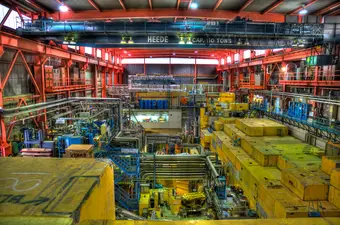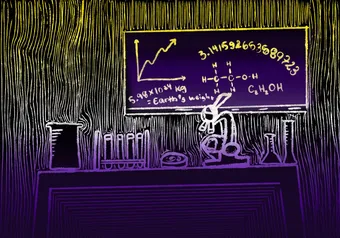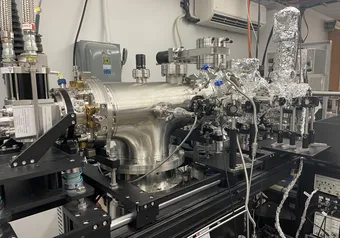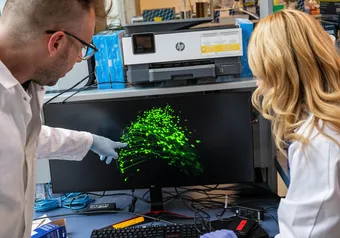For most of us, getting ready in the morning is one of the most mundane parts of our day, so remembering to put on a badge to track your radiation exposure after starting the coffee machine might seem more than a little out of place. But for the scientists and engineers at TRIUMF, the center of Canadian subatomic physics research, it is a familiar ritual.
The reason for taking these precautions is what lies buried five stories beneath the sprawling research facility located just south of Wesbrook Village: nearly half a dozen particle accelerators.
Using these incredible tools, researchers are investigating everything from new treatments for eye cancer to what gives superconductors their unique properties, to how the elements were formed.
The bulk of the research at TRIUMF relies on the use of its primary accelerator, a cyclotron measuring 18 metres across, the largest of its kind in the world. It is from the shape of this accelerator that the center gets its lollipop-like logo, since the six sectors of its enormous magnet have a distinct swirly shape.
TRIUMF’s cyclotron accelerates the stream of hydrogen ions continually injected into its centre using a combination of magnetic and electrical fields. The magnetic field keeps the ions moving in a circular path while, every half turn around the cyclotron, the electrical field gives the ions a “kick,” accelerating them and causing their path around the cyclotron to grow wider.
Using this technique, TRIUMF’s cyclotron is capable of accelerating particles to around 75 per cent of the speed of light. If you could travel that fast, you could reach Mars in less than the time it takes to watch an episode of The Office.
When it is up and running, the magnetic field that the cyclotron produces is so strong that even if you stand on top of the more than twenty feet of solid concrete that covers the accelerator, paper clips will stand up on a table (or even your hand) in alignment with the field lines.
[Sorry, video not found. You can contact webmaster@ubyssey.ca to fix the issue]
From the cyclotron, the ions can be directed down one of four beamlines leading from the accelerator to different experimental halls with targets and detectors to analyze the outcomes of the collisions of the charged particles with different experimental media.
As one would imagine, the process of accelerating particles and smashing them into things can produce lots of energy, so determining how to shield researchers from the resulting radiation is a crucial part of all the experiments carried out at TRIUMF.
That task is one of the many responsibilities of Doug Preddy, the beamlines group leader at the facility.
There are many different variables that must be accounted for when designing a shielding system for a particular experiment, but, according to Preddy, two of the most important are the specific kind of radiation and the energy levels involved.
For example, you can effectively shield against alpha radiation — which has a relatively low energy level — with only a few inches of air. To protect against x-rays, the few millimeters of lead in the aprons most of us are familiar with is sufficient. When you start dealing with gamma and neutron radiation (which have higher associated energies), however, effective shielding quickly becomes a much more involved process.
For shielding against gamma radiation, simple concrete is TRIUMF’s source of protection. When the main cyclotron is running, well over 2,000 tons of yellow concrete blocks stacked nine layers deep encase the beam lines as well as the experimental targets where radiation is generated during the collisions between particles.
As rearranging thousands of pounds of solid concrete is a very labor-intensive process, before Preddy and his team move a single block, they run computer simulations of planned experiments to test their shielding systems, helping to ensure that they will provide adequate protection.
Every year, TRIUMF shuts their cyclotron off for three months, giving them the opportunity to do all of the maintenance work necessary to allow the accelerator to run smoothly for the next nine months as well as rearrange the shielding blocks to protect new experiments.
It takes two to three full days of work — which were scheduled this year for the week of January 1 — requiring two cranes and a flatbed truck at the beginning of the maintenance period to move the blocks out of the cyclotron hall. Before the cyclotron is restarted, the entire process must be reversed.
For some kinds of radiation, however, even dozens of feet of concrete is not enough. When shielding experiments that produce neutron radiation — the same type produced during nuclear fusion and fission reactions — Preddy uses a combination of steel and concrete to slow the high-velocity particles to the point where they no longer pose a risk to researchers and technicians.
He used the analogy of a bullet to explain how the combination works. “If you shoot a bullet at a piece of plywood, it will go right through,” he said, “but if you put a piece of steel in front of the plywood, it will absorb enough of the kinetic energy that the plywood can stop the pieces.”
To protect one experiment, Preddy and his team gave it the Pharaoh treatment, entombing it in a pyramid of solid steel blocks that they then surrounded with even more layers of concrete.
While the work Preddy and his team do does not get the same public attention as the research at TRIUMF, their job makes all the science supported by the facility possible. Without them, the morning routine of a TRIUMF employee would require remembering a lot more than just a precautionary radiation badge.
First online
Share this article








